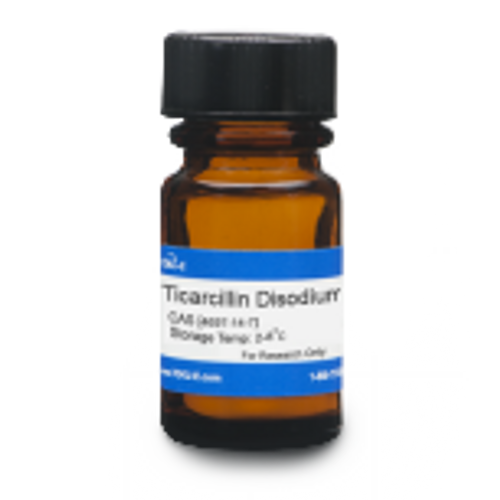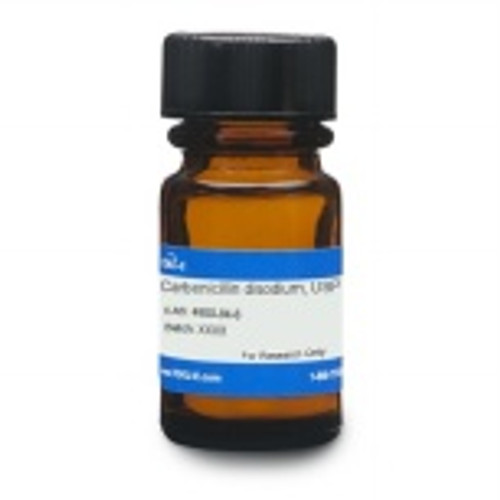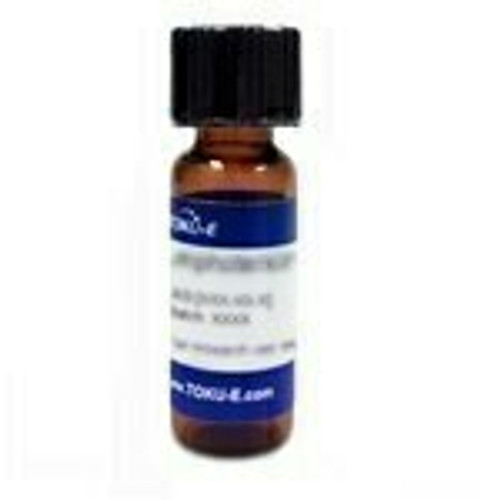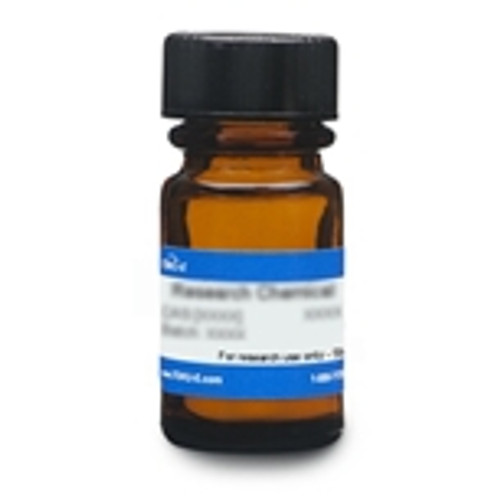Ticarcillin disodium, USP is an extended-spectrum (4th generation) β-lactam in the carboxypenicillin family. Ticarcillin Disodium (BRL 2288) was originally synthesized by Beecham Research Laboratories in 1967 and was made available for research, prior to 1970. Ticarcillin has bactericidal activity against many gram-positive and gram-negative bacteria, particularly Pseudomonas aeruginosa.
Ticarcillin Disodium is a cell wall synthesis inhibitor. It exerts bactericidal activity via inhibition of bacterial cell wall biosynthesis at the level of peptidoglycan cross-linking by inhibiting peptidoglycan transpeptidases.
In molecular biology, ticarcillin is used to as an alternative to Ampicillin Sodium (A042) to test the uptake of marker genes into bacteria. It prevents the appearance of satellite colonies that occur when ampicillin breaks down in the media. It is also used in plant molecular biology to kill agrobacterium, which is used to deliver genes to plant cells.
TOKU-E offers two forms of ticarcillin disodium: Ticarcillin Disodium (T027) and Ticarcillin Disodium w/ Clavulanate Potassium (Timentin) (T020). Both forms are freely soluble in aqueous solution. Clavulanate potassium (clavulanic acid) is a β-lactamase inhibitor which can irreversibly inactivate β-lactamase enzymes of β-lactam resistant microbes, preventing them from breaking down β-lactam antibiotics. Ticarcillin disodium can be combined with clavulanate potassium for greater efficacy against β-lactam resistant strains.
Ticarcillin Disodium, USP conforms to United States Pharmacopeia specifications.
| Mechanism of Action | β-lactams, like Ticarcillin Disodium, USP, interfere with PBP (penicillin binding protein) activity involved in the final phase of peptidoglycan synthesis. PBP’s are enzymes which catalyze a pentaglycine crosslink between alanine and lysine residues providing additional strength to the cell wall. Without a pentaglycine crosslink, the integrity of the cell wall is severely compromised and ultimately leads to cell lysis and death. Resistance to β-lactams is commonly due to cells containing plasmid encoded β-lactamases. |
| Spectrum | Ticarcillin has bactericidal activity against many gram-positive and gram-negative bacteria, particularly Pseudomonas aeruginosa. |
| Impurity Profile | Impurity A: (2S,5R,6R)-3,3-dimethyl-7-oxo-6-[[(thiophen-3-yl)acetyl]amino]-4-thia-1-azabicyclo[3.2.0]heptane-2-carboxylic acid (decarboxyticarcillin)||C14H15N2O4S2|339.41 Impurity B: (thiophen-3-yl)acetic acid|6964-21-2|C6H6O2S|142.18 Impurity C: 2-(thiophen-3-yl)propanedioic acid (3-thienylmalonic acid|21080-92-2|C7H6O4S|186.19 Impurity D: (4S)-2-[carboxy[[2-carboxy-2-(thiophen-3-yl)acetyl]amino]methyl]-5,5-dimethylthiazolidine-4-carboxylic acid (penicilloic acids of ticarcillin)||C15H17N2O7S2|401.44 Impurity E: (4S)-2-[[[2-carboxy-2-(thiophen-3-yl)acetyl]amino]methyl]-5,5-dimethylthiazolidine-4-carboxylic acid (penilloic acids of ticarcillin)||C14H17N2O5S2|357.43 |
| Microbiology Applications | Ticarcillin disodium is commonly used in clinical in vitro microbiological antimicrobial susceptibility tests (panels, discs, and MIC strips) against gram positive and gram negative microbial isolates. Medical microbiologists use AST results to recommend antibiotic treatment options for infected patients. Representative MIC values include:
Media SupplementsTicarcillin can be used as a selective agent in several types of isolation media: Burkholderia cepacia Agar Base - Burkholderia cepacia Selective Supplement |
| Plant Biology Applications | Timentin (Ticarcillin Disodium/Clavulanic Acid) has been used in agrobacterium-mediated genetic transformation studies. Timentin shows no deleterious effect on callus proliferation and regeneration in transgenic indica rise IR64 plants in comparison to cefotaxime and carbenicillin. |
| Molecular Formula | C15H14N2Na2O6S2 |
| Assay | Not less than 800 µg/mg (on dried basis) |
| References | Guzmán, Flavio, MD. "Beta Lactams Antibiotics (penicillins and Cephalosporins) Mechanism of Action.” Medical Pharmacology. Pharmacology Corner, 29 Nov. 2008. Web. 21 Aug. 2012. Pitout JD, Sanders CC, Sanders WE Jr. Antimicrobial resistance with focus on beta-lactam resistance in gram-negative bacilli. Am J Med 1997; 103:51. |
| MIC | Diplococcus pneumoniae| 0.1 - 1.6|| Haemophilus influenzae| 0.2 - 0.8|| |








